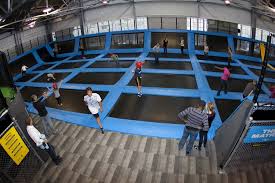Personal Injuries at Trampoline Parks Have Doctors Concerned
 Trampoline injuries result in approximately 100,000 visits to the emergency department every year. While most trampoline injuries occure on home trampolines, the growing popularity of indoor trampoline parks has led to a dramatic rise of injuries occurring specifically at these locations. In 2014, 6,932 people visited the emergency room after being injured at a trampoline park compared to 581 in 2010. A national study documenting this problem was recently published in Pediatrics. The study is Co-Authored by Connecticut Children’s Medical Center emergency physicians Steven Rogers, MD, and Jesse Sturm, MD, and pediatric emergency medicine fellow Kathryn Kasmire, MD.
Trampoline injuries result in approximately 100,000 visits to the emergency department every year. While most trampoline injuries occure on home trampolines, the growing popularity of indoor trampoline parks has led to a dramatic rise of injuries occurring specifically at these locations. In 2014, 6,932 people visited the emergency room after being injured at a trampoline park compared to 581 in 2010. A national study documenting this problem was recently published in Pediatrics. The study is Co-Authored by Connecticut Children’s Medical Center emergency physicians Steven Rogers, MD, and Jesse Sturm, MD, and pediatric emergency medicine fellow Kathryn Kasmire, MD.
Trampoline Parks are indoor parks with wall to wall trampolines. Despite the risk of injury, these parks are very popular with families and new parks are continuing to open all over the country. Statistics indicate that there are now around 500 trampoline parks open in the U.S. compared to 40 in 2011.
Children injured at trampoline parks are a little bit older than children injured on home trampolines with the most injuries reported for 13 year old males. Sprains and fractures are the most common injuries reported for both trampoline parks and home trampolines. Park visitors most often suffer extremity injuries (mostly dislocations) while home trampoline users tend to more often suffer head injuries. Park trampoline injuries more often required a hospital admission than home trampoline injuries. Fractures and spinal cord injuries often being the reason for admission.
Safety differs from park to park. One third of the injuries happen at landing with severe injuries reported from contact with the frame, the springs or the ground. The safer parks are those that have installed appropriate padding and wall trampolines as well as trampolines at ground level to prevent falls. However padding and additional “safety trampolines” can’t prevent collisions or falls on another child, another common cause of injury at trampoline parks. Decreasing the number of children allowed at the same time in the park reduces the risk of injury. Flips, which can cause cervical spine injuery are not allowed in some parks.
Another study in Australia and published 6 days ago in Injury Prevention reaches the same conclusion: Trampoline Parks are dangerous for children. The lead author of the study is doctor Christopher Mulligan of Sydney Children’s Hospital and the University of New South Wales’ Neuroscience Research. As a new indoor trampoline park opened near his hospital, Dr Mulligan studied the 40 children below 17 who were admitted to the emergency department for injuries which occurred at this specific park during a period of six months. Contrary to the American study, 55% of the children admitted were females. Causes of injuries were similar (bad landing, collision with other children and attempting flips or other special maneuvers). 55% were soft tissue injuries, 37.5% were fractured bones and one child suffered cervical injury
Picture source: wikipedia
 New York Personal Injury Attorneys Blog
New York Personal Injury Attorneys Blog


